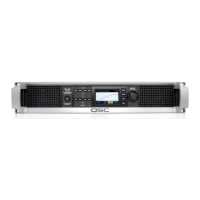8 QSC Audio Products LLC
Application Engineering Team
Physical layout
The PLD Series feature a neat, organized layout of the rear panel connectors and master power switch. The four XLR
inputs feature male loop-through connectors to allow easy daisy-chaining of input signals. There are six NL4 Speakon con-
nectors, including two that are exclusively used for bridged mono operation, that offer connections for all possible individu-
al, parallel, or bridged arrangements of amp channels.
For diagnostic, configuration, management, and other functionality, a USB Type B connector provides access to the amplifi-
er’s DSP through the free downloadable Amplifier Navigator application (available on the QSC web site).
For a roadworthy and secure power connection, a locking (when used with a corresponding power cable) IEC connector
helps make sure the system turns on every time you flip the switch.
The fan draws cooling air from the back of the amplifier chassis and pushes it through the internal heat sinks, to be ex-
hausted out the front panel perforations. Directing the air flow in this manner helps prevent a buildup of heated air within
the equipment rack.
The rack ears at the rear corners provide support in racks equipped with rear rails. To avoid stress and damage to the chas-
sis, we recommend attaching the rear rack ears to the equipment rack, especially in portable and mobile applications.
Block diagram
From input to output, the PLD Series power amps are unique. The electronically balanced inputs feed an analog input cir-
cuit with selectable sensitivity (at maximum gain)—either +4 dBu (1.23 V) or +14 dBu (3.88 V)—or selectable maximum
voltage gain: 26 dB (20×), 29 dB (28×), 32 dB (40×), or 35 dB (56×). These settings also help scale the input signal
more optimally to the analog-to-digital converter (ADC). The +4 dBu setting is more suitable for levels from consumer or
semi-pro audio equipment, and the +14 dBu is more suitable for professional-level signals. The gain settings, on the other
hand, are well suited for making design calculations in multi-amp systems.
An interesting aspect of a PLD Series power amp is the versatile configurability between its inputs and its output power
sections. Although the amp has four inputs and four outputs, they do not necessarily correspond one-to-one (although
they can be configured that way). Instead, a 4×4 matrix router (“Source Select” in the block diagram following this section)
allows the user to assign one or more inputs to the various output power sections. This is all done in the digital domain, in
the amp’s DSP circuitry.
From there, each output channel has a full assortment of processing features available for EQ, filtering (including cross-
over), dynamics (RMS and peak limiting), polarity, and delay (up to 50 ms on each channel).
Selectable via the menu are Intrinsic Correction™ processing profiles for select QSC loudspeaker systems, which allow
optimized voicing. Profiles for a number of other popular loudspeaker models are also selectable.

